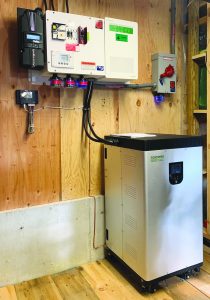
Chris Sparadeo
In the past, flooded lead-acid (FLA) batteries have been the first choice for those living off-grid. Although they have historically been the backbone of remote electrification, these batteries come with tradeoffs. Off-gassing, equalization charge, hydrometer readings are concepts that off-grid homeowners have come to grudgingly accept as part of the love-hate relationship with their battery banks.

In recent years, there have been major advances in battery-storage technology that have revolutionized the way power is stored and accessed. We now have a multitude of new chemistries, from salt water to numerous new lithium variations. Storing energy is becoming safer and easier as the revolution is ongoing.
One battery chemistry, lithium iron phosphate (LiFePO₄), has emerged as a shining star. These batteries have a 100% depth of discharge capability, no noxious off-gassing, and a long lifespan. They offer an extremely stable battery chemistry not susceptible to thermal runaway. They often come with robust manufacturer warranties. Also, unlike FLA batteries, LiFePO₄ batteries will likely supply rated storage capacity, regardless of how fast the power is drawn from it.
With LiFePO₄, there are plenty of choices when it comes to size, style, price, and options.
A manufacturer based in Pennsylvania, Fortress Power, and its 48-volt offering, the eVault 18.5kWh, present a perfect combination of performance and price. Each cabinet supplies a massive 18.5 kWh of usable energy storage and up to twelve units can be combined for a total of 222 kWh. The batteries have fast charging and discharging abilities, reducing the time it takes to charge. Fortress Power, with its integrated bussing system, has also solved the issue of inter-cell resistance, which can lead to reduced life span and performance.
The eVault’s most eye-catching feature is its digital display touch screen interface that provides data on the battery’s state of charge (SOC), along with charging and discharging statistics. This display is very important, as those who have used FLAs will appreciate. With typical lead-acid batteries, the user reads the voltage from a charge controller or inverter to understand the SOC. Unfortunately, FLA batteries and their voltage-based readings are imprecise at best, and even advanced battery-monitoring devices eventually fall out of calibration, leaving a user with an inaccurate understanding of the battery bank’s actual SOC.
FLA voltage readings can vary widely during normal operation, from often 44 to 52V at resting states.
LiFePO₄ chemistry is such that usable SOC typically exists in between 52 and 54V. This means at 53 volts, a battery bank might very well be at 80% SOC, but at 51.5 volts somewhere around 10%. This is a tight window of voltage, and the SOC of a LiFePO4 battery is not only established from voltage, but also determined by charging and discharging current. The eVault’s highly sophisticated battery-monitoring unit and integrated display screen give a precise reading of SOC, whereas screenless LiFePO4 batteries relying on voltage-based readings may not be as accurate.
Today, we are clearly in a new age for energy storage. Whether it be an off-grid, grid-tied battery backup, or an uninterruptable power source (UPS) system, the 18.5 kWh eVault offers reliable storage at an accessible cost, comparable to other makers’ batteries. It has a 10 year/6,000 cycle warranty, three years more than most of its competitors.
Homeowner Joe Hester Ingram has had experience with the Fortress eVault battery. He recommends it, saying, “I have been using off-grid solar to power our home in Wolcott, Vermont since the late 1970’s. I had been using the standard deep-cycle lead acid type batteries in my system. They have always been a challenge to manage all these years, with the need to monitor fluid levels and state of charge, with their life in service always being fewer years than I had always hoped for, with declining capacity as they aged. In October 2019, Catamount Solar replaced my system with new panels, controls, and batteries. The battery cabinet is the Fortress eVault 18.5. I have been extremely pleased with their performance, the freedom from monitoring and maintenance, and especially the LCD screen displaying state of charge information available at a glance on the front of the cabinet. The ten-year warranty adds promise to my new confidence going forward.” Ingram re-used the old system for a cabin on his property.
Gail Boyajian of Strafford, Vermont said of her new eVault, “Its compact footprint, the fact that it’s sealed so that there’s no issue of off-gassing and it’s energy density compared with the lead acid batteries it has replaced, make it a vastly superior storage system.”
Learn more about Fortress Power batteries at fortresspower.com or at (877) 497 6937.
Chris Sparadeo is a NABCEP Certified Professional PV Installer and is a member-owner of Catamount Solar as their off-grid specialist. Chris has been working in battery-based, off-grid solutions for nearly a decade. Feel free to send him an email with your questions at [email protected].









